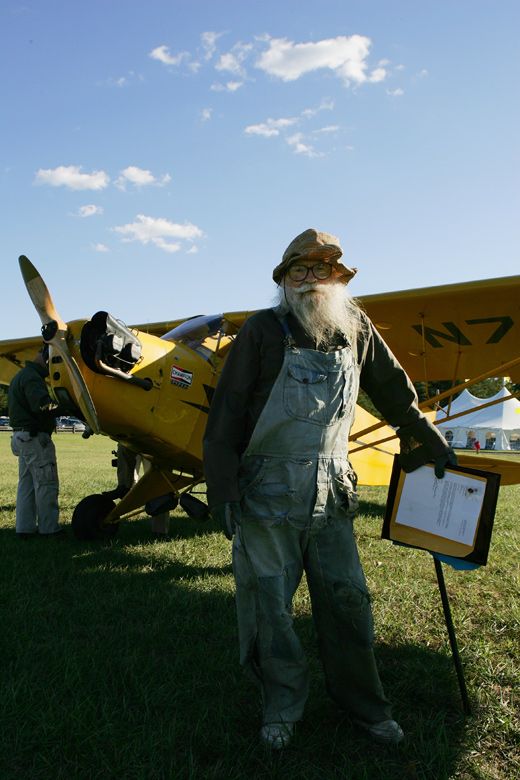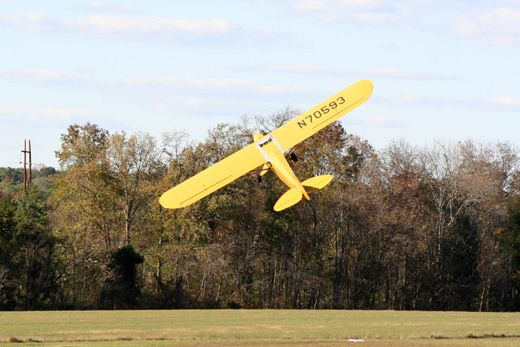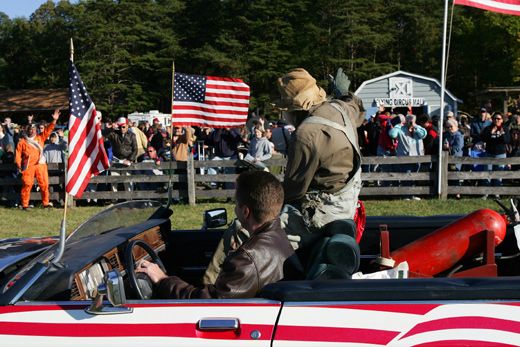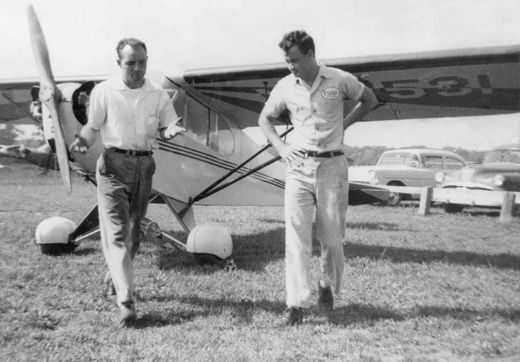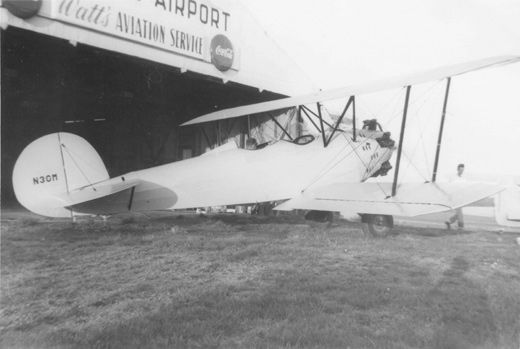Goodbye, Silas Hicks
Beloved showman Charlie Kulp dies at 96.
:focal(360x63:361x64)/https://tf-cmsv2-smithsonianmag-media.s3.amazonaws.com/filer/kulp-631-mar08.jpg)
Even if you'd seen his act a dozen times—and audiences at the Flying Circus Airshow in Bealeton, Virginia, saw it hundreds of times—Flying Farmer Charlie Kulp always made you smile. He flew a comedy routine as bumbling Silas Hicks for 34 years, pretending that he couldn't fly and, in the process, flying the most wonderful, hair-raising stunts that only a master could manage. In the act, Kulp pretended to be a first-time airplane passenger in a runaway Piper Cub that he tried to bring under control, as the airshow announcer frantically called out instructions. In his 64-year aviation career, Kulp has managed several airports; performed in airshows across the country, in Canada, and Great Britain; and taught hundreds to fly. He was inducted into the Virginia Aviation Hall of Fame in 1997. He died on October 17 at age 96. Kulp spoke with Air & Space Editor Linda Shiner in 2008, when he retired his Flying Farmer act.
A&S: What about the Piper J-3 makes it good for the act you flew for so many years?
Kulp: The visual trick. You have to solo the Cub from the back and the layman figures that everybody that sits up front is the pilot. But the other thing is the airfoil of the J-3 is a very, very good airfoil, and you can punish it quite a bit. It gives you little warnings, little slaps on the wrist, like "Don't do that again." [laughs] It'll tremble and shake and let you know where you're at.
A&S: And does it handle well for the kind of flying you do in the act?
Kulp: The main thing is…These little airplanes aren't built for heavy aerobatics. I used to kick mine around a lot, and some young people would come up to me after the show and say, "I didn't know a Cub would do that." And, knowing they probably had a Cub at home, I used to tell them, "They won't." Because I am at such a low speed, see. Speed is what hurts an airplane. And I'm at such a low speed when I slam it around, there's no pressure on the airplane.
A&S: How fast are you flying when you're performing?
Kulp: I'm generally running between 40 and 50 miles an hour, except when I go into the spin, I build up to about 100 miles an hour.
A&S: Wow. And what's the Cub's stall speed?
Kulp: It's right around 38, 39 miles an hour. And if you slam full rudder in there, all it's going to do is mush around. You're not hurting the airplane… [long pause] unless it stalls. Then you could kill the airplane. [laughs]
A&S: Ever come close?
Kulp: Eyeh…well, I've had some exciting times.
A&S: Ever crash it?
Kulp: No, no. This airplane has never been laid up. The last 15 or 16 years, I averaged 35 performances a year, so there was no time to get it disabled.
A&S: You mentioned that you'd seen acts similar to yours. Where would you see airshow acts in the fifties?
Kulp: Years ago, the Kiwanis clubs and Lion's clubs used to have airshows, and they would raise money that way. When the airshow business got too expensive, they started raising their money through carnivals, and they got out of the airshow business. Today, it takes mega-bucks to get airshows going. But I'd seen shows and flown in shows the Kiwanis clubs and Lion's clubs held. All the small airports used to have airshows. And the performers used to fly to make money. Like the old guy said, "It's either that or work."
A&S: How did you come to fly airshows in Great Britain?
Kulp: I went over there in '89, '90, and '91. There was a duke who had an estate in Badminton, England. The duke had a big estate and had his own private airfield. One of his caretakers was an ex-RAF pilot and a parachute jumper, and the duke let his caretaker start a parachute club there on the field. And that evolved into a show. He had a big fox hunt once a year, and that would bring in thousands of people in the spring. They started having this airshow in June or July and that brought in thousands of people.
A&S: How did you make the connection with the duke?
Kulp: One of the airshow pilots came over to the Flying Circus to look at an airplane one of our guys was selling. And he saw my act. He asked me if I would be interested in coming to England. About a year later—he had contacted the ex-RAF pilot at the duke's place—I went over to do a show. I got to know some of the airshow pilots and we hit it off pretty good.
A&S: Did it feel different, flying another pilot's Cub from the way your own airplane feels?
Kulp: Oh, yeah. I've done over 800 performances, and every performance except four, I've done in my airplane. I used two different airplanes in England, and I used a different airplane in a little town in Pennsylvania. The weather was bad, and I couldn't get up there, and they had a Cub up there for me. But when you fly an airplane on the edge, or anything that's a little bit different, it can get to you. One airplane had a stiff throttle on it, stiffer than mine, and things like that when you've been with the same airplane so long, it makes it almost seem like a different airplane.
A&S: How did you get interested in airplanes? What got you started?
Kulp: I was born in 1925. By the time I was old enough to know what was going on in the world, Lindbergh was still a big item. He flew the Atlantic in '27, but he stayed in the headlines for quite a few years after that. It wasn't just Lindbergh. You had the exploits of Howard Hughes and Roscoe Turner, Jimmy Doolittle—all of these individual people, you know. And to me it was just great to be an individual. A lot of kids thought about being an engineer—there's just one engineer on that train. Back in those days, we used to look at the captain of a ship or the engineer of a train or the pilot of an airplane. These were individual efforts.
When I finished high school in 1942, I went to work at the Blacksburg, Virginia airport. There was a government program for young people right out of high school. We lived in little barracks right on the Virginia Polytechnic Institute airport, and they gave us room and board. We maintained the airplanes that the college kids flew. In return, we were learning aircraft mechanics. And at that time, that was my only way of getting somewhere to touch an airplane.
The year before, my oldest brother had gone there and I just followed in his footsteps. By the time I got there, he had left; he had gone to work at the Wright-Patterson Air Force Base in Ohio.
A&S: Did you learn to fly at the college?
Kulp: While I was working on the airplanes, we couldn't take flying lessons at the college, so I hitchhiked over to Woodrum Field in Roanoke and took flying lessons over there. We were paid $10.21 a month and room and board, and so we used to go out and pick apples and cut corn with a hand knife for 25 cents an hour, and that's the way I earned my money for my flying lessons. A half-hour lesson then was $5, so it took a lot of hours of apple picking.
Q&A: Had you ever seen anything like your act before?
Kulp: Oh, yes. There's always a clown at an airshow, even before World War II. So I developed the act in 1973 in a Piper Cub.
Q&A: And was that your airplane?
Kulp: No. I used to be an FAA airplane inspector. I was an aircraft mechanic but I could also do the annual inspection of an airplane. I used to annual this Cub for the fellow who owned it from 1961 on, so when he told me that he wanted to sell it, my oldest son bought it. I had been trying to get him involved in aviation. I taught both of my boys to fly there at the Flying Circus, but they never did do anything with it, so I gradually bought the airplane away from my oldest son. So it's been in the family since 1972.
Q&A: And is that the same aircraft you fly today?
Kulp: Right. Like I say, I'd been inspecting and licensing the airplane, so I knew the airplane. Years ago, I got a letter from a retired colonel from the Air Force in Texas. He said he went on the Internet to see who owned his airplane that he used to have. And he found out that it was me. I also used to be a private pilot examiner; I could issue a pilot's license. He said that in 1954, I had given him a flight check in that airplane. I was at Hyde field then, in Clinton, Maryland. So I had given him his pilot's license, and he sent me a copy of a page in his logbook with the airplane's N-number with my name signed to it. It's a funny thing. I'd been around this airplane since the '50s and didn't know it. It was really nice of him to send it.
A&S: At the time you were a pilot examiner, could you also give a check flight to your own students?
Kulp: Yes. Except I taught my first wife how to fly, and I would not give her flight check. She was a little upset about it, but I told her every time she made a landin' and she bounced a little bit, she didn't want people to be saying that I had just given her a license. So I sent her to the FAA, and she got her flight check by the federal government.
A&S: How'd she do?
Kulp: Did good. But you know what I mean. If she ever did flub a landing, and all of us do from time to time, they would just say "Well she was just given her license by her husband" and I didn't want that monkey to be on her back.
A&S: Did you enjoy flight instruction?
Kulp: Oh, yes. I loved it very much. But I thought they were throwing too much stuff in there at the same time. When a person was trying to learn how to fly, I thought the best thing was to teach them how to fly, until they got good, and then crank in all the radio, and instruments, and all this stuff in there later.
A&S: I like that idea. Kulp: Well, sure. That's what knocked a lot of young people out of learning to fly. I mean I was teaching kids to fly. But you go to an airport today and the first thing they do is slam ten books up on the counter when you walk in. The kid's already in school. He's had enough of school. And I say the first thing you do is get 'em in the damn airplane.
A&S: Did you like teaching in the Cub? What airplanes did you use for instruction?
Kulp: I taught in many airplanes. I taught in the Aeronca Champion; in the PA-12, the SuperCruiser—that was a good trainer. All of my training was in a tail dragger-type airplane.
A&S: Is that the way to go? If you want to fly a tail dragger, should you learn to fly in a tail dragger?
Kulp: I don't say that. I had a lot of airline pilots who wanted to bring their kids to me, you know, because that's the way they had learned. But by then, we'd gotten into all of this fancy way of teaching, so I told 'em the best thing to do would be to go on and send 'em through the school they've gotta go through, then send 'em to me and I'll check 'em out on a tail dragger.
A&S: And Ken Hyde mentioned that when you were managing airports, there would usually be a number of young people who would work around the place doing maintenance, or even sweeping up, and exchange their work for flying lessons.
Kulp: Yeah, I did some of that. Even then, flying was cheap. When I learned it was about $10 an hour and after the war when I was teaching, it was only $15 an hour, and the people that you got—most of 'em were young people. And young people didn't have much, just like I didn't have much money. And if I could help some of 'em I would.
A&S: Were you also selling rides at the time?
Kulp: Yeah, that's where you got a lot of your students from. I sold rides for $2 a person and about every fourth ride, I'd end up with a student.
A&S: Sounds like a really good time.
Kulp: You were really close to it; you were all of it. Most of the airports now are owned by the state and have an airport manager with six or seven helpers under him. When I was the airport manager, I was the flight instructor, and if they had a restaurant, I cooked the hamburgers, I gassed the airplanes, I worked on the airplanes, and taught people to fly. So there was no money paid out for an airport manager because the airport manager made his money teaching people to fly.
